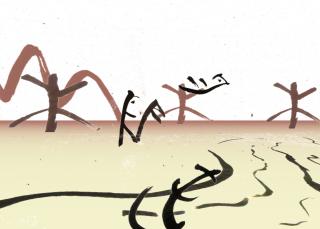Glyphcoder
Yin Liu
Glyphcoder is an interactive tool that encourages viewers to playfully create their own language and notations
http://www.thingiebox.com/glyphcoder

This installation is the last part of a series of studies aimed at re-interpreting pictorial language systems in the digital age. The study culminates in a translation of text into glyphs through a computer program that encodes new glyphs based on user interaction. This installation then brings the digital output back into analogue form whereby the audience can then playfully recreate the glyphs with magnetized tree sticks on a canvas. The choice of tree sticks references the origin of languages in its most primitive form.
Background
evolution of languages in different geographic regions of the world, with particular emphasis on phonetic and pictorial languages
how languages shape the way we think
studies of difference in 'west' and 'east' thinking, e.g. namely reductionist v.s. holistic thinking.
computationally generate languages or forms that have the appearance of text and language
Audience
People that are interested in different ways of self expression through languages. A future potential user group is children under age 7 who are found to be keen to create their own imaginary languages.
User Scenario
A visitor comes to the installation. He/she is interested so I explain on monitor screen what the application does. He/she gives it a try and designs glyphs for a messages he/she wants to encode. He/she is then invited to recreate the message with tree sticks on one of three canvases. The next visitor will create a new message after observing what is already 'written' on the canvas by the previous visitor.
Implementation
The app is written in processing and will be shown on a monitor. The canvases are made out of steel flat sheets covered with canvas material. Each of the tree sticks has a magnet attached at the back side so they stay on the canvas through suction.
Conclusion
Looking back, my thesis started with research and basically was very much an exploration of forms to best communicate my message. It took many different experiments to arrive at Glyphcoder. I very much enjoyed the process. Though it was very stressful not knowing what the final product would be, I am really glad that I insisted on it. In retrospect, I would not have arrived at Glyphcoder if I did not take the earlier steps and 'wrong' paths.
The journey is more important than the destination.
Background
evolution of languages in different geographic regions of the world, with particular emphasis on phonetic and pictorial languages
how languages shape the way we think
studies of difference in 'west' and 'east' thinking, e.g. namely reductionist v.s. holistic thinking.
computationally generate languages or forms that have the appearance of text and language
Audience
People that are interested in different ways of self expression through languages. A future potential user group is children under age 7 who are found to be keen to create their own imaginary languages.
User Scenario
A visitor comes to the installation. He/she is interested so I explain on monitor screen what the application does. He/she gives it a try and designs glyphs for a messages he/she wants to encode. He/she is then invited to recreate the message with tree sticks on one of three canvases. The next visitor will create a new message after observing what is already 'written' on the canvas by the previous visitor.
Implementation
The app is written in processing and will be shown on a monitor. The canvases are made out of steel flat sheets covered with canvas material. Each of the tree sticks has a magnet attached at the back side so they stay on the canvas through suction.
Conclusion
Looking back, my thesis started with research and basically was very much an exploration of forms to best communicate my message. It took many different experiments to arrive at Glyphcoder. I very much enjoyed the process. Though it was very stressful not knowing what the final product would be, I am really glad that I insisted on it. In retrospect, I would not have arrived at Glyphcoder if I did not take the earlier steps and 'wrong' paths.
The journey is more important than the destination.


